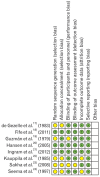Metoclopramide for Milk Production in Lactating Women: A Systematic Review and Meta-Analysis
- PMID: 34871486
- PMCID: PMC8648493
- DOI: 10.4082/kjfm.20.0238
Metoclopramide for Milk Production in Lactating Women: A Systematic Review and Meta-Analysis
Abstract
Background: Breastfeeding is recognized as the optimal form of nutrition for the physical and neurological development of infants and is considered the most significant way to prevent child mortality. This study aimed to assess the effectiveness of metoclopramide for enhancing milk production in lactating women.
Methods: We searched the Cochrane Central Register of Controlled Trials and MEDLINE for randomized controlled trials comparing metoclopramide with a placebo, no treatment, or other galactagogue drugs. We included breastfeeding women with term or preterm infants.
Results: We retrieved 164 records from our search of the electronic databases and 20 records from other sources. Eight trials involving 342 lactating women that used metoclopramide were included in this review after assessing the eligibility criteria. The meta-analysis of these trials revealed that metoclopramide did not increase the milk volume of the intervention groups compared to that of the control groups. There was a significant increase in the serum concentrations of prolactin when the mothers were administered metoclopramide. No significant adverse events were reported.
Conclusion: Metoclopramide did not improve milk production in lactating women. Therefore, we do not recommend using metoclopramide to increase milk production in lactating women.
Keywords: Breast Feeding; Galactagogues; Lactation; Metoclopramide.
Conflict of interest statement
No potential conflict of interest relevant to this article was reported.
Figures





References
-
- World Health Organization. United Nations Children’s Fund . Global strategy for infant and young child feeding. Geneva: World Health Organization; 2003.
-
- Amir LH. Managing common breastfeeding problems in the community. BMJ. 2014;348:g2954. - PubMed
-
- Stuebe AM. Enabling women to achieve their breastfeeding goals. Obstet Gynecol. 2014;123:643–52. - PubMed
LinkOut - more resources
Full Text Sources

